clarinet
All scores that include a part for at least one clarinet.
Bach - Prelude & Fugue - Wind Quintet
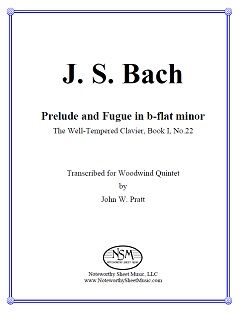 Prelude and Fugue, WTC Book I, No.22, by J.S.Bach
Prelude and Fugue, WTC Book I, No.22, by J.S.Bach
Transcribed for Woodwind Quintet by John W. Pratt, PDF $16.00
Score, 6 pages; Parts, 2 pages each for Flute, Oboe (plus alternate Alto Flute), Clarinet, Horn, and Bassoon; Total, 20 pages.
PreviewBach - Prelude and Fugue, BWV 532 - arr. Woodwind Quartet
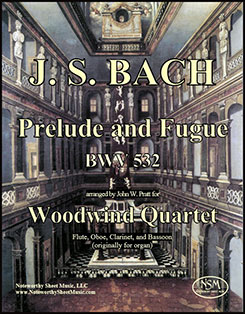 Prelude and Fugue, BWV 532, by J. S. Bach
Prelude and Fugue, BWV 532, by J. S. Bach
Arranged for Woodwind Quartet by John W. Pratt
Score and Parts, PDF $15.97
Click to listen to computer-generated audio samples from the score; audio clips from the Prelude (m4-22) and the Fugue (m14-27), are separated by a brief pause.
Score, 16 pages; Flute part, 5 pages; Oboe part, 6 pages; Bb Clarinet part, 6 pages; Bassoon part, 5 pages;Total, 46 pages.
PreviewBach - Toccata, Adagio, and Fugue - Wind Quartet
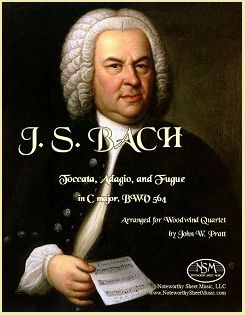 Toccata, Adagio, and Fugue in C major, BWV 564, by J. S. Bach
Toccata, Adagio, and Fugue in C major, BWV 564, by J. S. Bach
Arranged for Woodwind Quartet by John W. Pratt
Score and Parts for Flute, Oboe, Clarinet, & Bassoon, PDF $21.25
excerpted from JWP’s © foreword to the edition:
Among J. S. Bach's big organ works, the Toccata, Adagio, and Fugue, BWV 564 is atypical in ways that make it unusually well suited to transcription for woodwind quartet. Unlike most, it has a middle movement, an Adagio with an elaborate and gorgeous melody which lies comfortably for flute and can benefit greatly from the shaded, nuanced dynamics and articulations that a solo flutist can provide. The other winds bring out Bach's beautiful voice-leading in the Adagio's two inner parts and its marching but not martial bass. The four-part Fugue is unusual, too—light and lighthearted, happily adaptable to woodwinds, with no call for great power and, rather than a climactic ending, a fading coda that defies convincing treatment on the organ. The exuberant Toccata starts with an extended manual solo passage ... mostly in 32nd notes, which ... I felt it would be more effective as a game of frequent handoffs between instruments than as a series of longer individual études. The pedal solo, mostly 16ths, calls for the extra weight of doubling.
Click to listen to a computer-generated audio sample from the end of the Toccata into the beginning of the Adagio.
Score, 17 pages; Flute part, 6 pages; Oboe part, 5 pages; Bb Clarinet part, 5 pages; Bassoon part, 4 pages; Total, 46 pages.
PreviewBartók - For Children - arr. for Winds
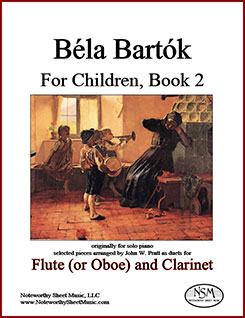 For Children, by Béla Bartók
For Children, by Béla Bartók
piano pieces based on Hungarian and Slovakian folksongs
Selected pieces arranged as woodwind duos, trios, or quartets by John W. Pratt and presented in multiple editions, organized by instrumentation and nationality.
Béla Bartók was not only a major composer in a post-Romantic extended tonal style, but he was also a superb pianist with a precise technique, a scholarly explorer of folk music, and a serious pedagog. Folk melodies and harmonies strongly influenced his music, both indirectly and often directly, including many of his orchestral and chamber works, as well as solo piano pieces ranging in difficulty from easy to virtuosic. His For Children (Gyermekeknek, 1908-1909, Sz. 42) was written for solo piano, and the original Books 1 and 2 contained 42 pieces after Hungarian folksongs and 43 pieces after Slovakian folksongs, respectively. Besides the usual purposes of music written for children, Bartók sought to broaden their musical experience with, for instance, modal and other scales, and harmonies outside the traditional western canon. For Children is by no means pablum; though the notes may be easy to play, these pieces have a lot else to offer. They were written when Bartók’s folksong research was well under way and his notational efforts at their peak. Students, teachers, and every-day players can make as much of them as they like ... as simple tunes for beginners content to learn basic notes and rhythms, or as more advanced studies on articulation, musicality, etc. —extracted from the preface by JWP
John Pratt has arranged selected pieces from the For Children books as various duos, trios, and quartets for wind instruments. As presented originally by Bartók, many of the folksongs are entirely or mostly in two voices, like Bach’s two-part inventions in style if not structure or harmony, and thus convenient for wind duo and no more childish for Bartók than Bach. Many others are also adaptable to duos of flute or oboe and clarinet or bassoon, mostly by spreading the left-hand chords in time. Still others of the For Children pieces are more suitable for a wind trio of flute (or oboe), B-flat clarinet, and bassoon, or a quartet of flute, oboe, B-flat clarinet, and bassoon. To compare the specific songs included in our editions with the complete set arranged for piano available in Bartók’s publications, visit the For Children listing on imslp.org.
All of the NSM editions described below are available as downloadable PDFs. We provide scores, but not separate parts, as all players can easily play off copies of the scores, which are organized for convenient page turns when the PDFs are printed two-sided in their entirety. Click the Preview button to view a page of the score from each edition. To order, in the table at the bottom of this webpage, check the box for the edition you would like to purchase, click Add to Cart, then click Checkout.
► Bartók - For Children, Book 1 - selected pieces arr. as Duets for Flute (or Oboe) and Clarinet 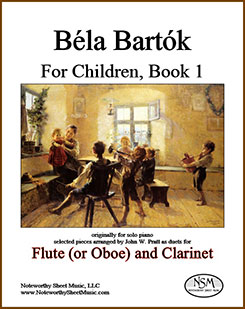 This edition includes 25 pieces from Book 1 arranged as duets; all of them can be played by B-flat clarinet and either flute or oboe, but for six of the pieces we also include alternative versions with octave changes that are better suited to oboe. The pieces included are Nos. 1-15, 22-26, 29, 31, 21, 40, and 42. Click to listen to computer-generated audio samples from the score; audio clips of #11 "Me and the Rain" with flute and clarinet and #32 "Wedding Day and Night" with oboe and clarinet are separated by a brief pause.
This edition includes 25 pieces from Book 1 arranged as duets; all of them can be played by B-flat clarinet and either flute or oboe, but for six of the pieces we also include alternative versions with octave changes that are better suited to oboe. The pieces included are Nos. 1-15, 22-26, 29, 31, 21, 40, and 42. Click to listen to computer-generated audio samples from the score; audio clips of #11 "Me and the Rain" with flute and clarinet and #32 "Wedding Day and Night" with oboe and clarinet are separated by a brief pause.
Score, 26 pages; Total, 30 pages.
Preview: Book 1, Flute (or Oboe) and Clarinet
► Bartók - For Children, Book 1 - selected pieces arr. as Duets for Oboe (or Flute) and Bassoon
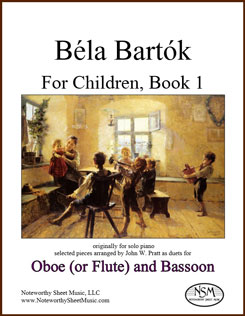 Our oboe (or flute) and bassoon edition includes the same 25 pieces from Book 1 as our flute and clarinet edition described above, except here they are arranged and optimized as duets for oboe and bassoon, with alternative versions better suited for flute and bassoon provided for two of the folksongs.
Our oboe (or flute) and bassoon edition includes the same 25 pieces from Book 1 as our flute and clarinet edition described above, except here they are arranged and optimized as duets for oboe and bassoon, with alternative versions better suited for flute and bassoon provided for two of the folksongs.
Preview: Book 1, Oboe (or Flute) and Bassoon
► Bartók - For Children, Book 2 - selected pieces arr. as Duets for Flute (or Oboe) and Clarinet

Our Book 2 edition of arrangements for flute (or oboe) and clarinet duo includes 23 pieces: Nos. 1-6, 8, 10-13, 16-20, 22, 25, 26, 29, 31, 35, and 36. All of these pieces can be played by B-flat clarinet and either flute or oboe, but we also include alternative versions that are more suitable for oboe for three of the pieces.
Score, 17 pages; Total, 22 pages.Preview: Book 2, Flute (or Oboe) and Clarinet
► Bartók - For Children, Book 2 - selected pieces arranged as Duets for Oboe (or Flute) and Bassoon
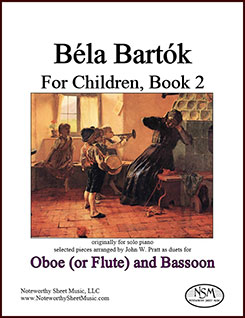 The oboe (or flute) and bassoon edition includes the same 23 pieces from Book 2 described above for flute and clarinet, here arranged and optimized as duets for oboe and bassoon, with an alternative version better suited for flute for one of the pieces.
The oboe (or flute) and bassoon edition includes the same 23 pieces from Book 2 described above for flute and clarinet, here arranged and optimized as duets for oboe and bassoon, with an alternative version better suited for flute for one of the pieces.
Preview: Book 2, Oboe (or Flute) and Bassoon
► Bartók - For Children, Book 1 - selected pieces arranged as Trios for Flute (or Oboe), Clarinet, and Bassoon
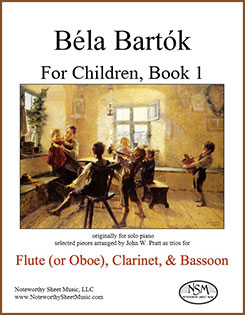 In this trio edition, we present 20 songs from Book 1, including 14 that are also available as duo arrangements in the editions listed above and 6 that are only offered in our trio edition. The pieces are Nos. 1-9, 11, 13-15, 19, 20, 30, 35, 39, 41, and 42. The trios are arranged for flute or oboe, B-flat clarinet, and bassoon. Click to listen to a computer-generated audio sample from #39 "Insect Wedding".
In this trio edition, we present 20 songs from Book 1, including 14 that are also available as duo arrangements in the editions listed above and 6 that are only offered in our trio edition. The pieces are Nos. 1-9, 11, 13-15, 19, 20, 30, 35, 39, 41, and 42. The trios are arranged for flute or oboe, B-flat clarinet, and bassoon. Click to listen to a computer-generated audio sample from #39 "Insect Wedding".
Score, 21 pages; Total, 24 pages.
Preview: Book 1, Flute (or Oboe), Clarinet, and Bassoon Trio
► Bartók - For Children, Book 2 - selected pieces arranged as Trios for Flute (or Oboe), Clarinet, and Bassoon
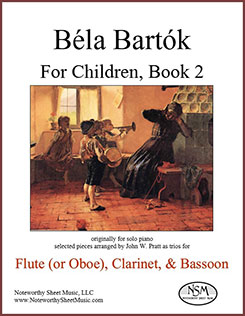 Here Mr. Pratt offers eighteen of Bartók’s Book 2 Slovakian folksongs in arrangements for a woodwind trio of flute or oboe, B-flat clarinet, and bassoon; the pieces included are Nos. 2, 3, 7, 9, 11-14, 16, 17, 21, 25, 26, 28, 29, 32, 33, and 42. Ten of these songs are also included in our duo arrangement publications.
Here Mr. Pratt offers eighteen of Bartók’s Book 2 Slovakian folksongs in arrangements for a woodwind trio of flute or oboe, B-flat clarinet, and bassoon; the pieces included are Nos. 2, 3, 7, 9, 11-14, 16, 17, 21, 25, 26, 28, 29, 32, 33, and 42. Ten of these songs are also included in our duo arrangement publications.
Preview: Book 2 Flute (or Oboe), Clarinet, and Bassoon Trio
► Bartók - For Children, Book 1 - selected pieces arranged for Wind Quartet (Flute, Oboe, Clarinet, and Bassoon)
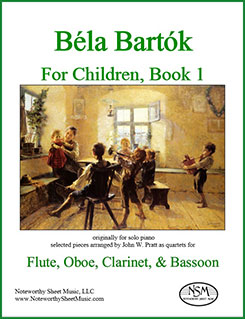 This edition includes eleven of Bartók’s Hungarian folksongs in arrangements for a woodwind quartet of flute, oboe, B-flat clarinet, and bassoon. Two of these songs, Nos. 19 and 20, are also included in our trio arrangement publication, but none are replicated in the duo arrangement editions; the quartet publication includes Book 1 Nos. 16-21, 27, 28, and 36-38.
This edition includes eleven of Bartók’s Hungarian folksongs in arrangements for a woodwind quartet of flute, oboe, B-flat clarinet, and bassoon. Two of these songs, Nos. 19 and 20, are also included in our trio arrangement publication, but none are replicated in the duo arrangement editions; the quartet publication includes Book 1 Nos. 16-21, 27, 28, and 36-38.
Score, 11 pages; Total, 14 pages.
Preview: Book 1, Flute, Oboe, Clarinet, and Bassoon Quartet
► Bartók - For Children, Book 2 - selected pieces arranged for Wind Quartet (Flute, Oboe, Clarinet, and Bassoon)
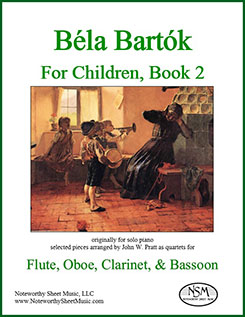 This edition presents seventeen of Bartók’s Book 2 Slovakian folksongs in arrangements for woodwind quartet (flute, oboe, B-flat clarinet, and bassoon). Four of these songs, Nos. 11, 14, 25 and 28, are also included in our trio arrangement publication, and several are included in the duo arrangement editions. The Book 2 songs arranged here as quartets are Nos. 5, 8, 11, 14, 15, 18, 23- 25, 27, 28, 30, 31, 34, 37, 38, and 43. Click to listen to a computer-generated audio sample that consists of ~32” of song #5 Bird in Flight (Theme & part of Var.1, through m34), followed immediately by #18 Former Flame in its entirety.
This edition presents seventeen of Bartók’s Book 2 Slovakian folksongs in arrangements for woodwind quartet (flute, oboe, B-flat clarinet, and bassoon). Four of these songs, Nos. 11, 14, 25 and 28, are also included in our trio arrangement publication, and several are included in the duo arrangement editions. The Book 2 songs arranged here as quartets are Nos. 5, 8, 11, 14, 15, 18, 23- 25, 27, 28, 30, 31, 34, 37, 38, and 43. Click to listen to a computer-generated audio sample that consists of ~32” of song #5 Bird in Flight (Theme & part of Var.1, through m34), followed immediately by #18 Former Flame in its entirety.
Preview: Book 2, Flute, Oboe, Clarinet, and Bassoon Quartet
Beach - Ecstasy - Voice (or Afl), Alto Flute (or Cl), and Piano
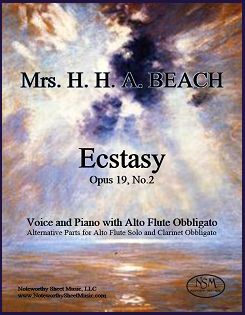 Ecstasy, Op.19 No.2, by Mrs. H. H. A. Beach
Ecstasy, Op.19 No.2, by Mrs. H. H. A. Beach
Two versions, for "Low voice (in Db)" or "High voice (in Eb)", with Alto Flute Obbligato (transcribed) and Piano.
Alternative parts for Alto Flute Solo and Bb Clarinet Obbligato.
Program Notes by Peter H. Bloom.
Piano Scores, Voice Parts, Alto Flute Obbligato Parts, and alternative Alto Flute Solo Parts and Clarinet Obbligato Parts; PDF $8.99
Noteworthy Sheet Music was thrilled to publish our edition of Amy Marcy Cheney Beach's song Ecstasy in 2017, in celebration of the 150th anniversary of the composer's birth. The idea to make Ecstasy available to a broader combination of players and singers came from flutist Peter H. Bloom, who proposed that the piece would be an excellent vehicle with which instructors might inform students (early and advanced alike) about interpretation of the highly romantic late 19th century idiom. To that end, we have packaged together in a single edition Mrs. H. H. A. Beach's two versions of Ecstasy, for "low voice (in Db)" and "high voice (in Eb)", with each version including transcriptions of the obbligato (originally for violin) for either alto flute in G or clarinet in Bb, and an alternative solo part in the form of an alto flute transcription of the voice line. Thus, multiple performance variations are possible, including high or low voice and piano with either alto flute or clarinet obbligato, or fully instrumental versions for alto flute and piano, or two alto flutes and piano, or alto flute, clarinet, and piano.
Scores, 8 pages (4 pages each version); Voice parts, 2 pages (1 page each version); Alto Flute Obbligatos, 2 pages (1 page each version); Clarinet Obbligatos, 2 pages (1 page each version); Alto Flute solo parts, 2 pages (1 page each version); Total, 20 pages.
PreviewBloom - From the Drawer - Tenor or Soprano, Flute, Clarinet, Bassoon, Horn
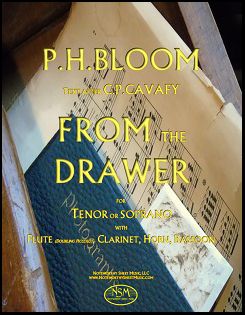 From the Drawer, by Peter H. Bloom
From the Drawer, by Peter H. Bloom
Contemporary Composition for Tenor or Soprano, with Flute (doubling Piccolo), Clarinet in B-flat, Bassoon, and Horn in F
Score and Parts, PDF $13.99
Peter H. Bloom is a Boston-based flutist, whose original compositions and arrangements are published by Noteworthy Sheet Music. From the Drawer was written for Tenor or Soprano, with Flute (doubling Piccolo), Clarinet, Bassoon, and Horn, and provides a musical setting for the intensely emotional poem by Constantine Cavafy.
The musical setting is a sonic image of the intensely emotional response to a flood of memory that informs the poet’s narrative: now pensive, now anxious, now wistful, now joyous, now fraught, now resigned, and ever mercurial." P. H. Bloom, September 19, 2015
Our sheet music edition of From the Drawer was featured on the New Products page of the Summer 2016 edition of "The Flutist Quarterly", journal of The National Flute Association.
Score, 14 pages; Tenor or Soprano part, 2 pages; Flute part, 4 pages; Clarinet part, 3 pages; Bassoon part, 3 pages; Horn part, 3 pages; Total, 29 pages.
=========================================================
We also offer a professionally-printed hard copy edition of From the Drawer for $23.78 plus a $5.95 shipping and handling fee. Due to prohibitively high international shipping rates, we ship print editions only to addresses in the USA. Please use the Contact Us form to let us know which hard copy publication(s) you would like to purchase, along with your email contact information and USPS mailing address. We will then send you a PayPal invoice for the sale and, once we receive notice from PayPal that you have paid for the item(s), we will ship your music to the address provided.
=========================================================
Brahms - Drei Duette - 2 Voices and/or Instruments and Piano
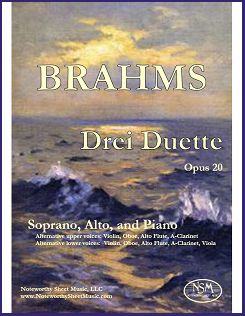 Drei Duette, Op.20, by Johannes Brahms
Drei Duette, Op.20, by Johannes Brahms
Transcribed for Mixed Voice, Instruments, and Piano by John W. Pratt
Score for Soprano, Alto, and Piano; Transcribed upper voice Parts for Violin/Oboe, Alto Flute, and A-Clarinet; and Transcribed lower voice Parts for Violin/Oboe, Alto Flute, A-Clarinet, and Viola; PDF $12.99
Composed in 1858–1860, the Drei Duette, Op. 20, for soprano and alto are the earliest of Johannes Brahms' duets and quartets for solo voices and piano. The three songs are titled Weg der Liebe (1. Teil), Weg der Liebe (2.Teil), and Die Meere. Except for brief canonic passages in No. 1, the voices have the same words, sung simultaneously, mostly in parallel thirds and sixths. The accompaniments are straightforward, without Brahmsian ensemble challenges but not without harmonic interest. Many have found the songs Mendelssohnian. The words come from the collection Stimmen der Völker of Johann Gottfried Herder (1744–1803). The first two are translations by Herder of two parts of a Northern English folk poem Love will find out the Way. The third is Italian in origin.
The vocal parts lie well for many instruments, opening the possibility of mixed voice and instrument, as well as fully-instrumental, performances. If one voice is replaced by an instrument, no words will be lost and the result will be a song with wonderful instrumental obbligato and piano accompaniment. If two instruments are used, the result is a beautiful "song without words." We include in our edition transcriptions of both voices for oboe/violin, alto flute in G, and clarinet in A, and of the lower voice for viola as well. Our transcriptions provide slurs to suggest a vocal style to instrumental players and to facilitate coordination of the instrumental parts with those of the voices. We also provide a re-notated piano/vocal score, in which repeat signs are used in the second and third songs to save page turns, rather than writing out the multiple stanzas as in the original. For those needing only the piano/vocal score, the Breitkopf & Härtel edition is in the public domain and freely available on imslp.org.
Piano/Vocal Score, 10 pages; Instrumental Parts, 3 pages each; Total, 42 pages.
PreviewBrahms - Two Songs, Op.91 - Clarinet
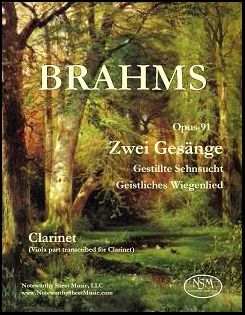 Two Songs, Op.91, by Johannes Brahms
Two Songs, Op.91, by Johannes Brahms
Transcribed for Clarinet by John W. Pratt (part originally for viola)
Clarinet Part, PDF $6.99
The two chamber music songs of Brahms' Zwei Gesänge, Op.91 were composed specifically for his dear friends, the violinist/violist Joseph Joachim and the mezzo-soprano Amalie Schneeweiss, who were married in 1863. The songs (for alto, viola, and piano) were written over 20 years apart, but Brahms published them together as Op.91 in 1884.
"Gestillte Sehnsucht", which appears first in the Op.91 pairing, was actually written second, in 1884. The song sets the text of the poem by Friedrich Rückert (1788-1866). "Gestillte Sehnsucht" is a nature poem, filled with images of forests at sunset, gentle breezes, and twittering birds. Rückert is famous not only for his exquisite poems themselves but also for the great inspiration his work provided to numerous prominent composers, in addition to Brahms. "Geistliches Wiegenlied" (Sacred Cradle Song) was first composed in 1863-1864, and later revised. The viola opens with the melody of the medieval Christmas carol "Joseph, lieber Joseph mein." The singer has her own variation of the melody, and enters after the first stanza of the viola's carol. The song is a beautiful cradle-rocking lullaby, in 6/8 time.
It is said that the viola was Brahms' favorite stringed instrument, and the composer gave the viola a major role in both of these songs, allowing it to open both pieces before the singer enters. Clarinetists have long coveted these viola parts, and various performances have provided clear evidence that a successful outcome can be achieved with the substitution of a clarinet for the viola in Op.91. So when a clarinetist friend of ours asked us to create a transcription for him, we gladly obliged. Our edition of the clarinet part adapts the first song, "Gestillte Sehnsucht", for clarinet in A, and the second, "Geistliches Wiegenlied", for clarinet in Bb. The original piano score and voice part are in the public domain, readily available as free PDF downloads from IMSLP.org.
Clarinet part, 4 pages; Total, 8 pages.
PreviewBrahms – Variationen über ein Thema von Robert Schumann – Pf, Fl, Ob, Cl, Bn
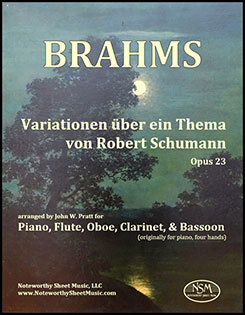 Variationen über ein Thema von Robert Schumann, Op.23, by Johannes Brahms
Variationen über ein Thema von Robert Schumann, Op.23, by Johannes Brahms
Arranged for Piano, Flute, Oboe, Clarinet, and Bassoon by John W. Pratt
Piano Score and Wind Parts, PDF $16.99
- adapted from John W. Pratt’s foreword to the edition: Brahms’s Variations on a Theme by Robert Schumann, Op.23, were written in tribute to his friend, for piano four hands. Yet how often have you heard this exquisite masterpiece, in any form? Arranging it as a quintet for piano and winds allows realization of its implicit orchestral effects and incorporation of contrasting and beautiful woodwind sonorities while preserving its many special piano sonorities and its personal, chamber music qualities and will, hopefully, encourage performance. The variations range from delicately decorative (Var. I) to spectral (IV) to warmly Brahmsian (many) to bravura (IX) and even perhaps witty (V and VII). The final variation (X) is an amazing valedictory, a funeral march which becomes combined with the theme and is suffused throughout with sadness, solemnity, resignation, and reaffirmation, by turns and even simultaneously. Especially apt contributions by the woodwinds in this arrangement include, to mention just two, the appreciative chuckles accompanying the rollicking theme of Var. V and the chorale effect at the end of Var. X. At the same time, the arrangement allows the piano to fulfill its usual roles in chamber ensembles and to contribute some special colorings of its own, including the multi-octave filigree of Var. I, the layout of the accompaniments in the first part of Var. III and last part of Var. V, the bass rumbles of Var. IV and Var. X, and the two-hand octaves in Var. VI and Var. IX.
Listen to a computer-generated audio clip of the Theme; of course, real live instruments will sound even better:
The Preview below is a page of the score from Var. VI. Note that the score is presented in concert pitch.
Score, 28 pages; Flute, Oboe, B-flat Clarinet, and Bassoon parts, 4 pages each; Total, 48 pages.
PreviewBridge - Three Songs, viola part trans. for Clarinet
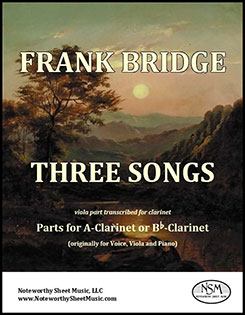 Three Songs, by Frank Bridge
Three Songs, by Frank Bridge
Transcribed parts for Clarinet by C. A. Vater (originally for viola)
Alternative Parts for A-Clarinet or B-flat-Clarinet (no score), PDF $8.99
Frank Bridge composed his Three Songs for Voice, Viola, and Piano in 1906-1907, setting to music one poem each by Matthew Arnold (Far, far from each other), Heinrich Heine (Where is it that our soul doth go?), and Percy Bysshe Shelley (Music when soft voices die). Both the poetry and the music are richly romantic, addressing with high emotion the various stages of grief experienced over the loss of a loved one. Bridge is an accessible post-romantic composer who should be better known. We at Noteworthy Sheet Music thought his Three Songs would work equally well with clarinet substituting for the original viola, thereby creating a new opportunity for its performance by the appealing ensemble of voice, clarinet and piano. We prepared transcribed parts for both A-clarinet and B-flat-clarinet, so players can choose which instrument they prefer for each of the three movements. Our edition includes both of the clarinet part options but no score, as a good quality PDF of the Bridge score for voice, viola and piano is available as a free download from imslp.org and our clarinet parts work well with the original score’s piano and voice lines.
A-Clarinet part, 4 pages; B-flat-Clarinet part, 4 pages; Total, 14 pages.
Preview